Table of contents
- Comparison test: Ducati Hypermotard old against new When the time comes, the bike has overcome the old Hypermotard’s faults?
- Ducati Hypermotard 821 vs. 1100 EVO Part 1
- The new one only perks up at high speeds
- Tires work wonders
- Ducati Hypermotard 821 vs. 1100 EVO Part 2
- The predecessor shines with a radial hand pump
- PS readings
- Data of the old Hypermotard 1100 EVO
- PS data
- Data of the new Hypermotard 821
- PS data
- Evaluation and judgment
- PS judgment
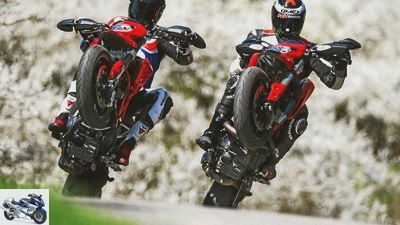
Artist

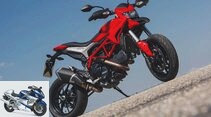
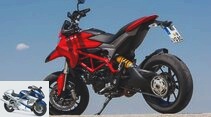
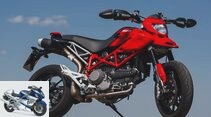
22nd pictures
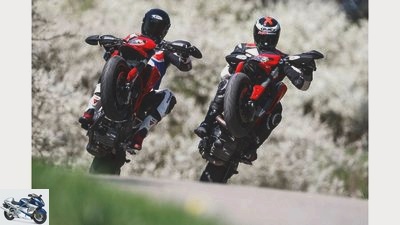
jkuenstle.de
1/22
Ducati Hypermotard 1100 Evo (old) and Ducati Hypermotard 821 (new).
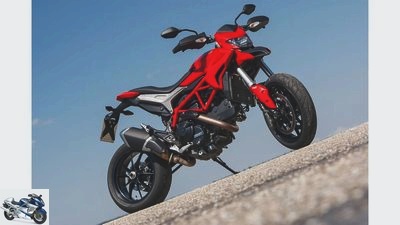
jkuenstle.de
2/22
Ducati Hypermotard 821.

jkuenstle.de
3/22
Ducati Hypermotard 821.

jkuenstle.de
4/22
Ducati Hypermotard 1100 Evo.
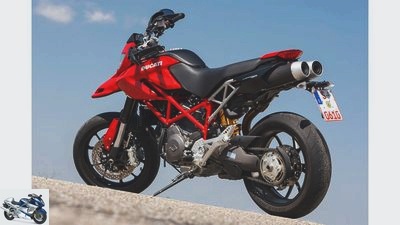
jkuenstle.de
5/22
Ducati Hypermotard 1100 Evo.
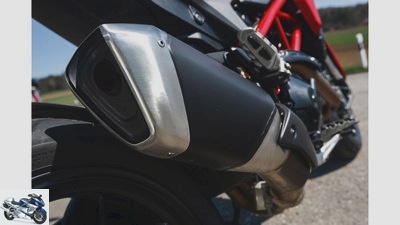
jkuenstle.de
6/22
The exhaust of the Ducati Hypermotard 821.
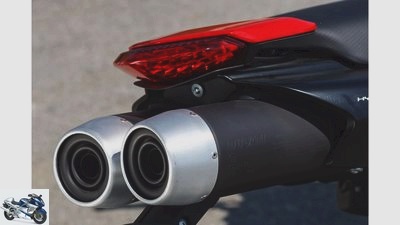
jkuenstle.de
7/22
The exhaust of the Ducati Hypermotard 1100 Evo.
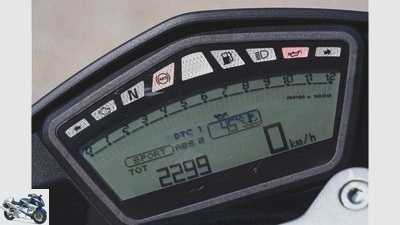
jkuenstle.de
8/22
The old and new cockpits do not differ in shape. The new one offers more functions thanks to additional electronics.
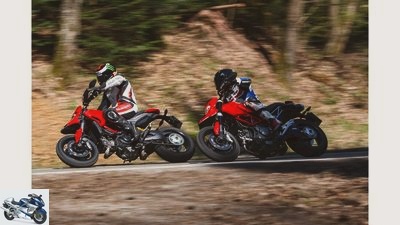
jkuenstle.de
9/22
Ducati Hypermotard 821 (new) and Ducati Hypermotard 1100 Evo (old).
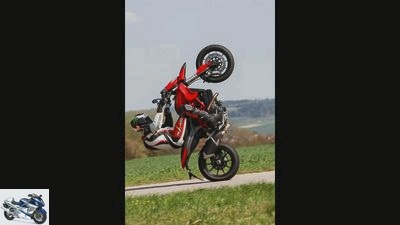
jkuenstle.de
10/22
Ducati Hypermotard 821.
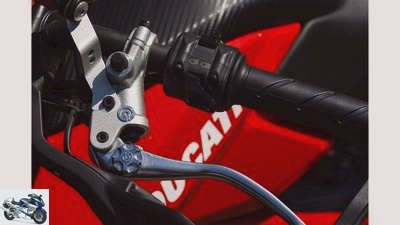
jkuenstle.de
11/22
The old one is more elegant – it works with an adjustable hydraulic clutch. Both require quite a lot of hand strength.
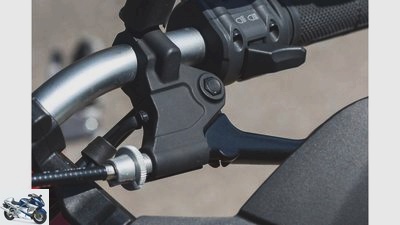
jkuenstle.de
12/22
The new Hypermotard has to make do with a clutch operated by a cable pull.
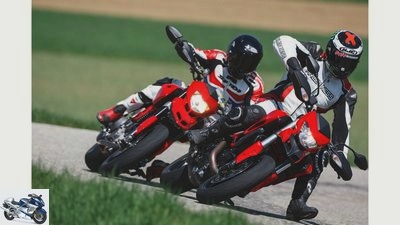
jkuenstle.de
13/22
Ducati Hypermotard 1100 Evo (old) and Ducati Hypermotard 821 (new).
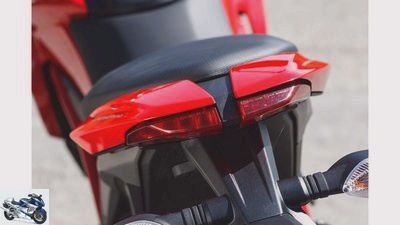
jkuenstle.de
14/22
The rear of the Ducati Hypermotard 821.
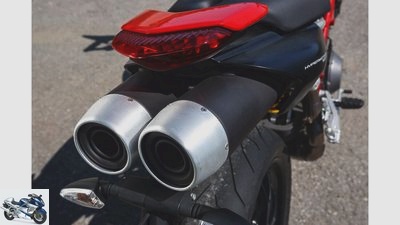
jkuenstle.de
15/22
The rear of the Ducati Hypermotard 1100 Evo.
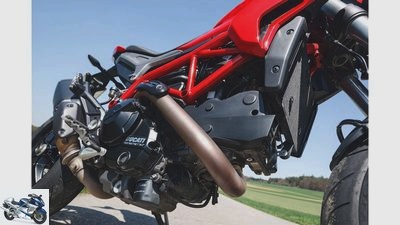
jkuenstle.de
16/22
The completely new 821 cubic engine with water cooling and four-valve technology.
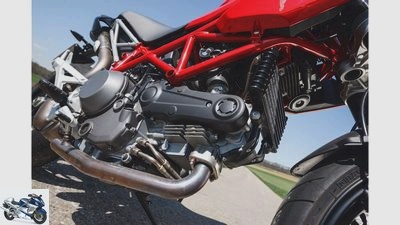
jkuenstle.de
17/22
The old, air / oil cooled two-valve with 1078 cubic.

jkuenstle.de
18/22
Ducati Hypermotard 1100 Evo.
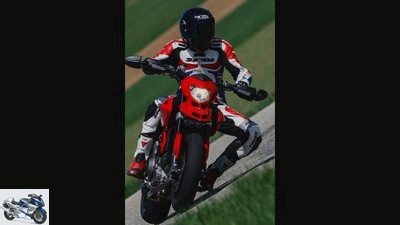
jkuenstle.de
19/22
Ducati Hypermotard 1100 Evo.
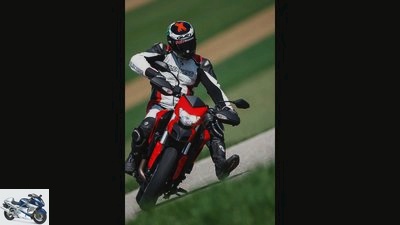
jkuenstle.de
20/22
Ducati Hypermotard 821.
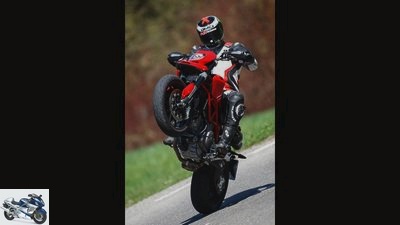
jkuenstle.de
21/22
Ducati Hypermotard 1100 Evo.
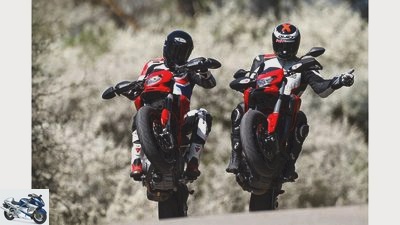
jkuenstle.de
22/22
The Ducati Hypermotard 821 wins the group test: The new one scores tremendously because it is absolutely state-of-the-art when it comes to electronics. But there are also really points for the awesome engine. The chassis is their weak point – unfortunately!
The Ducati Hypermotard 1100 Evo: Even without ABS and TC, the 1100 version of the Hypermotard has something: for example a good chassis, a cultivated engine and the fun factor.
motorcycles
Comparison test Ducati Hypermotard old against new
Comparison test: Ducati Hypermotard old against new
When the time comes, the bike has overcome the old Hypermotard’s faults?
Content of
Just in time for the delayed start to the motorcycle season, Ducati is supplying dealers with the Testastretta-fired Hypermotard. PS clarifies whether the new one has overcome the somewhat dubious driving characteristics of the predecessor.
Jo Bauer
05/21/2013
Ducati Hypermotard 821 vs. 1100 EVO Part 1
Thundering V2 rumble. According to the noise, two Ducatis are heating up against each other. You can’t see them yet, but the typical sound hangs over the valley. The farmer, who is currently examining his sowing, pauses for a moment. His gaze scans the red burners and their riders who are chasing through the winding bends on the other side of the fields. One whips his vehicle in the hanging-off mode, the other in supermoto style through the corners on sparkling footrests. The good man at the beginning of the food supply chain seems to like the spectacle, because it puts a smile on his distinctive face. To our astonishment, he even acknowledged the show with a friendly “thumps up”. We kindly thank you with a wheelie insert. This underlines that you don’t always have to be fast if you want to experience something with the Hypermotards.
Buy complete article

Comparison test: Ducati Hypermotard old against new
When time comes, the old Hypermotard’s faults have been overcome?
6 pages) as PDF
€ 2.00
Buy now
Both test candidates have a certain coolness, a plump sound and offer a lot of driving fun. However, they generate it in very different ways. The main reason why the characters are so different is that there is a sharp cut in the sequence of models between them. Example engine: after six years it has Ducati made the jump to the Testastretta engine. In the new drive, there are four instead of two valves per cylinder, and water cooling instead of air cooling takes care of the thermal well-being. The new propellant now has to make do with 821 instead of 1078 cubic centimeters. No problem, after all, the new one pushes a solid 110 hp onto the shaft instead of the 95 horses in the 1100s. Thanks to the reduced displacement, the weight of the entire crank drive has also been reduced. The lower rotating and oscillating masses have a very positive effect on the handling of the new Hypermotard. Fast curve changes require significantly less force. It’s super easy! The 1100 Evo from 2012 is a bit more sedate.
The new one only perks up at high speeds
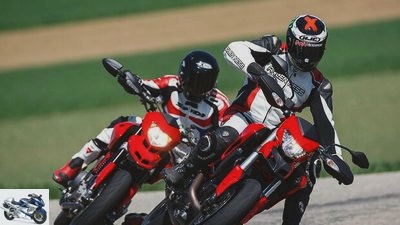
jkuenstle.de
At first glance, the two Ducati Hypermotards can hardly be distinguished.
The “operational” speed ranges of the two hypers are fundamentally different. If the 1100 can be driven easily and lazily from the speed limit, the new one only really perks up at higher speeds. But that doesn’t really matter, because the engine control works brilliantly. Loose and jerk-free can be accelerated cruising with 3000 rpm. In this area, the large-volume Hypermotard picks up the chain a little bit rough. The Testastretta is so much more maneuverable than the air-cooled Big Twin and can effectively go up to around 10,700 rpm. From 7000 rpm, the new frog really pushes. It’s brilliant how the Testastretta does this with no load changes.
When it comes to throttle acceptance, the testers prefer the “medium” level. The supposedly sportiest – “high” – is simply too aggressive, and the twin jumps too brutally on the gas. The air-cooled predecessor manages without different mapping characteristics. She pushes out from below with a fat “old school” V2 blow. However, if you don’t shift up quickly, the propulsion is only tough from 7000 rpm. Understandable, because the rev limiter already intervenes at 8500 rpm. We remember: That’s when the new girl really dances Samba.
MOTORCYCLE market: Used Ducati Hypermotard 821
MOTORCYCLE market: Used Ducati Hypermotard 1110 S
MOTORCYCLE market: Used Ducati Hypermotard 1110 EVO SP
Tires work wonders
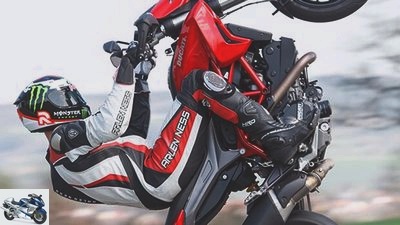
jkuenstle.de
The new Ducati Hypermotard is not necessarily about speed, but about the driving experience.
However, both drives have one thing in common. The gears can be shifted resinously and sometimes only mechanically. The couplings are again fundamentally different. If the old one has a rattling, hydraulically operated dry clutch, the clutch plates of the new one rotate in an oil bath with sophisticated anti-hopping technology. Unfortunately, however, the hydraulic actuation was saved and a cable was installed. In any case, both clutches require too much manual force – nothing unknown to Ducatisti.
We paid a lot of attention to the chassis because the first Hypermotard annoyed us so much. One or the other driver of the original Hypermotard has already been thrown over the folding front wheel, and we have castigated this unpleasant characteristic from the beginning. With our tips at the time, which, by the way, were also incorporated into the series in the following years, this naughtiness of the brisk Bolognese could be eliminated to some extent.
So we were all the more excited for the new one. Lo and behold: It also poses a riddle to us, but everything is much safer than it was then. The 821 wants to be moved in curves with slight counter pressure on the handlebars and constant steering corrections – a fine, straight line does not seem possible. If you adjust to it, you might be able to live with it, but with a newly designed bike – does it have to be? We tried it and finally found a wonderfully simple solution: survive the initial Pirelli Diablo Rosso II tires and simply separate them at the end of the running-in period! As a test, we put on the Road Attack II from Conti. What a change! Neutral in all situations, no more counter-pressure, no righting moment when braking in an inclined position.
Ducati Hypermotard 821 vs. 1100 EVO Part 2
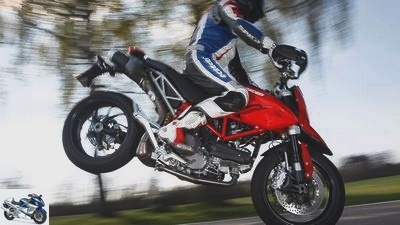
jkuenstle.de
One or the other driver of the original Hypermotard has already been thrown over the folding front wheel.
Easy play with the new one when drifting
Unfortunately, the new one saved in terms of the adjustability of the chassis. Only the rebound on the shock absorber can be adjusted, which when you look at the market is actually an attribute for mid-range naked bikes that cost well below 10,000 euros. For us, a real point of criticism of the otherwise lavishly equipped Hypermotard in 2013, especially since it dips very quickly and deeply on the fork when the jagged braking brake is applied. The shock absorber, on the other hand, is quite tight – something Ducati fans know from other models too. The 2012 Evo is much better positioned because it not only has fully adjustable rebound and compression stages on the shock absorber and fork – actually state of the art on such fun bikes, but also works much more harmoniously in the interaction of the front and rear. If you expect more from the new Hyper, you have to get the high-end version SP.
But back to our candidates: If you want to drift in the supermoto style, the slightly heavier new Hypermotard is easy. It can be put into fat drifts almost neutrally via a small steering impulse and the rear brake. It remains full and stable in the bank position. The predecessor, on the other hand, demands a lot from the pilot for lateral drift, because even the large-volume engine has a very high braking torque. In addition, there is the rough clutch, which unfortunately can torpedo the most beautiful drift all too abruptly. Used buyers should therefore definitely buy them a retrofit anti-hopping clutch.
The predecessor shines with a radial hand pump
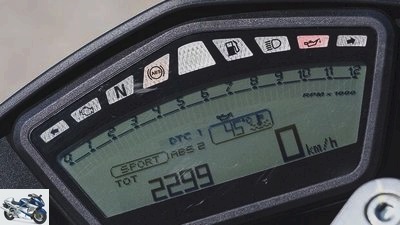
jkuenstle.de
The old and new cockpits do not differ in shape. The new one offers more functions thanks to additional electronics.
When it comes to electronics, the new Hypermotard is of course the boss in the ring. This can already be seen on the on-board computer, which allows a lot of gimmicks and in which the pilot can save his individual feel-good program. Our tip for really sporty natures: In the “Sport” mode, the traction control on level three, then it still allows wheelies, but still reliably suppresses sudden loss of grip in an inclined position. We have deactivated the ABS, which regulates well, for drifts. As already described, under “Engine” we stay on “medium”. This can be saved and retrieved at any time – a great thing when you’ve finally reached your ballerina after driving through town or traveling.
On the brakes again: In 2013, it will be decelerated in line with the times with an excellent Bosch ABS. Hardly any wishes remain unfulfilled here. There are two levels to choose from, both of which delay the detention limit. However, level one allows stoppies to the point of rollover! Stage two intervenes much earlier. Nevertheless, a rollover can still be provoked here – especially downhill.
The brake decelerates sharply in a sporty manner. Even the rear brake works unusually well for Ducati. The predecessor, on the other hand, shines when it comes to the brake, especially because of its wonderful radial hand pump. Otherwise, the first Hypermotards were downright notorious for their fat stoppers at the front, but have been tamed considerably over the years. In the 2012 Evo, the brake now seems dull and listless. In order to dance on the front wheel with the 1100, you have to grip the lever firmly with your whole hand. There was no ABS in 2012, which is why pilots often lay down with the front wheel folded. The brake can still be used for normal to sporty trips.
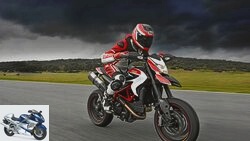
Supermoto
Driving report Ducati Hypermotard (2013)
Thunder rage in continuous rain
read more
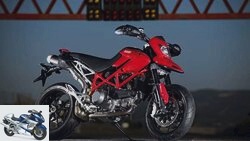
Supermoto
Driving report Ducati Hypermotard 1100 Evo / Evo SP (2010)
Seven kilograms of weight saved
read more
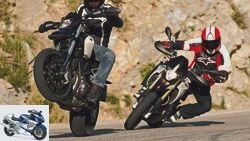
Supermoto
Ducati Hypermotard 796 versus Aprilia Dorsoduro
Italian mid-range supermotos
read more
PS readings

BILLION
The measured values of the new and old Ducati Hypermotard in direct comparison.
The performance diagram clearly visualizes the different characters of the two twins. The almost 1100 cubic centimeters of displacement of the old Hym send a lot of pressure to the transmission from 3000 rpm and leave the 821 cubic of the new far behind. The counter comes at 7500 rpm. This is where the fireworks start with the Testastretta propellant. The illustrious play of the two Ducs could not be more impressive.
Data of the old Hypermotard 1100 EVO
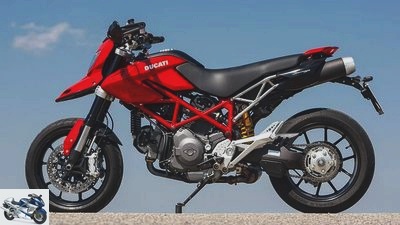
jkuenstle.de
The old Hypermotard also has its charm.
| Set up Country road | |
| fork | |
| stat.neg. Suspension travel | 36 mm |
| Pressure level | 2.5 U open |
| Rebound | 2 U open |
| Shock absorber | |
| stat.neg. Suspension travel | 17 mm |
| Pressure level | 2 U open |
| Rebound | 1 K open |
| all damping settings counted from completely closed; static negative spring deflection standing vertically without driver; U = revolutions; K = clicks | |
| Acceleration** | Draft** | Top speed * | |||
| 0-100 km / h | 0-150 km / h | 0-200 km / h | 50-100 km / h | 100-150 km / h | |
| 3.6 s | 7.2 s | 17.6 s | 6.8 s | 6.0 s | 220 km / h |
| * Manufacturer information; ** PS measurement | |||||
PS data
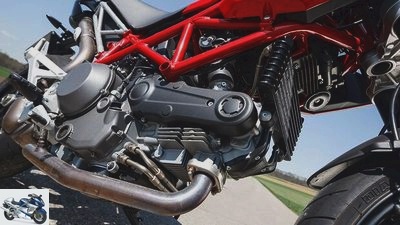
jkuenstle.de
The old, air / oil-cooled two-valve engine of the Hypermotard with 1078 cubic.
drive
Two-cylinder 90-degree V-engine, two valves / cylinder, 70 kW (95 PS) at 7500 / min *, 105 Nm at 5750 / min *, 1078 cm³, bore / stroke: 98.0 / 71.5 mm , Compression ratio: 11.3: 1, ignition / injection system, 45 mm throttle valves, hydraulically operated multi-disc oil bath clutch, six-speed gearbox, G-Kat, chain.
landing gear
Steel tubular space frame, steering head angle: 66 degrees, caster: 100 mm, wheelbase: 1465 mm, upside-down fork,
Inner fork tube Ø: 50 mm, adjustable in spring base, rebound and compression stage. Central spring strut with deflection, adjustable in spring base, rebound and compression stage. Suspension travel front / rear: 165/141 mm.
Wheels and brakes
Light alloy cast wheels, 3.50 x 17 / 5.50 x 17, front tires: 120/70 ZR 17, rear: 180/55 ZR 17, first tires: Pirelli Diablo Rosso, 305 mm double disc brakes with radially attached four-piston fixed calipers at the front, 245 mm single disc with two-piston fixed caliper at the rear.
measurements and weight
Length / width / height: 2180/1200/1220 mm, seat / handlebar height: 860/1080 mm, handlebar width: 780 mm, 192.5 kg fully fueled, v./h .: 46.8 / 53.2%.
Rear wheel power in last gear
64 kW (87 PS) at 206 km / h
consumption
Fuel type: Super unleaded. Average test consumption: 6.8 liters / 100 km, tank capacity 12.4 liters, range: 182 km.
Base price
11750 Euro plus inc. (YOC 2012)
* Manufacturer information
Data of the new Hypermotard 821
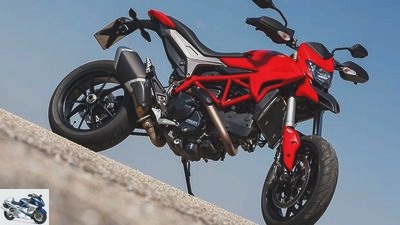
jkuenstle.de
The electronics of the new Hypermotard are completely contemporary.
| Set up Country road | |
| fork | |
| stat.neg. Suspension travel | 32 mm |
| Pressure level | – |
| Rebound | – |
| Shock absorber | |
| stat.neg. Suspension travel | 20 mm |
| Pressure level | – |
| Rebound | 2 U open |
| all damping settings counted from completely closed; static negative spring deflection standing vertically without driver; U = revolutions; K = clicks | |
| Acceleration** |
Draft** |
Top speed * |
|||
| 0-100 km / h | 0-150 km / h | 0-200 km / h | 50-100 km / h | 100-150 km / h | |
| 3.3 s | 6.3 s | 13.7 s | 4.7 s | 5.4 s | 220 km / h |
| * Manufacturer information; ** PS measurement | |||||
PS data
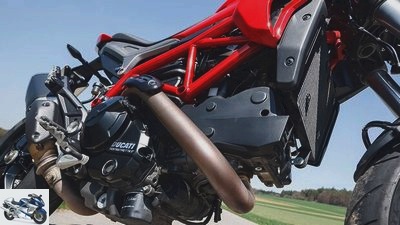
jkuenstle.de
The completely new 821 cubic engine with water cooling and four-valve technology from the new Hypermotard.
drive
Two-cylinder 90-degree V-engine, four valves / cylinder, 81 kW (110 PS) at 9250 / min *, 89 Nm at 7750 / min *, 821 cm³, bore / stroke: 88.0 / 67.5 mm , Compression ratio: 12.8: 1, ignition / injection system, 52 mm throttle valves, mechanically operated multi-disc oil bath anti-hopping clutch, six-speed gearbox, G-Kat, chain.
landing gear
Steel tubular space frame, steering head angle: 64.5 degrees, caster: 104 mm, wheelbase: 1500 mm, upside-down fork,
Inner fork tube: 43 mm, not adjustable. Directly hinged, laterally attached shock absorber, adjustable in spring base and rebound. Suspension travel front / rear: 170/150 mm.
Wheels and brakes
Cast light alloy wheels, 3.50 x 17 / 5.50 x 17, front tires: 120/70 ZR 17, rear: 180/55 ZR 17, first tires: Pirelli Diablo Rosso II, 320 mm double disc brakes with radially attached four-piston fixed calipers at the front, 245 -mm single disc
with two-piston fixed caliper at the rear, ABS.
measurements and weight
Length / width / height: 2150/920/1295 mm, seat / handlebar height: 880/1120 mm, handlebar width: 780 mm, 199 kg fully fueled, v./h .: 49.2 / 50.8%.
Rear wheel power in last gear
73.5 kW (100 PS) at 194 km / h
consumption
Fuel type: Super unleaded. Average test consumption: 6.5 liters / 100 km, tank capacity 16 liters, range: 246 km.
Base price
11190 Euro plus inc.
* Manufacturer information
Evaluation and judgment
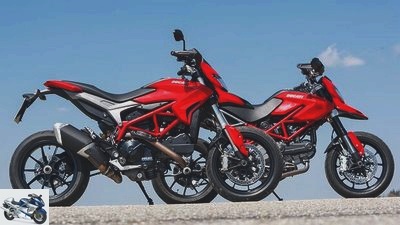
jkuenstle.de
The new Hypermotard pulls past the old one – but there is still a problem with the chassis.
| Max. Points |
Ducati Hypermotard 821 (old) |
Ducati Hypermotard 1100 EVO (New) |
|
| drive | |||
| acceleration | 10 | 2 | 4th |
| Draft | 10 | 3 | 6th |
| Performance development | 10 | 7th | 8th |
| Responsiveness | 10 | 9 | 9 |
| Load change reaction | 10 | 8th | 9 |
| Running culture | 10 | 9 | 8th |
| Gear actuation | 10 | 5 | 5 |
| Gear ratio | 10 | 6th | 9 |
| Clutch function | 10 | 5 | 8th |
| Traction control | 10 | – | 9 |
| Subtotal | 100 | 54 | 75 |
| landing gear | |||
| Driving stability | 10 | 7th | 7th |
| Handiness | 10 | 7th | 9 |
| Cornering stability | 10 | 7th | 8th |
| feedback | 10 | 8th | 8th |
| Suspension tuning in front | 10 | 7th | 6th |
| Suspension tuning rear |
10 | 7th | 6th |
| Braking effect | 10 | 7th | 9 |
| Brake metering | 10 | 7th | 9 |
| Righting moment when braking | 10 | 8th | 7th |
| ABS function | 10 | – | 8th |
| Subtotal | 100 | 65 | 77 |
| Everyday life and driving fun | |||
| Sitting position | 10 | 8th | 7th |
| Windbreak | 10 | 1 | 2 |
| Furnishing | 10 | 5 | 8th |
| consumption | 10 | 6th | 6th |
| Driving fun | 10 | 8th | 9 |
| Subtotal | 50 | 28 | 32 |
| Total | 250 | 147 | 184 |
| placement | 2. | 1. |
PS judgment
1. Ducati Hypermotard 821
The new one scores tremendously because it is absolutely state-of-the-art when it comes to electronics. But there are also really points for the awesome engine. The chassis is their weak point – unfortunately!
2. Ducati Hypermotard 1100 Evo
Even without ABS and TC, the 1100 version of the Hypermotard has something: for example a good chassis, a cultivated engine and the fun factor.
Related articles
-
Top test Ducati Multistrada 1100
Gargolov motorcycles Top test Ducati Multistrada 1100 Top test Ducati Multistrada 1100 Turboprop Clear the start for the greatest air-cooled Ducati of…
-
Chovikov motorcycles Comparison test: fun bikes Comparison test: Funbikes, BMW R 1200 GS, Ducati Multistrada 1100 BMW R 1200 GS, Ducati Multistrada 1100…
-
Driving report: Ducati Hypermotard 796
manufacturer motorcycles Driving report: Ducati Hypermotard 796 Driving report Ducati Hypermotard 796 (2009) Sister of the 1100 with a smaller…
-
Comparison test: BMW R 1200 GS, Ducati Hypermotard 1100 S, KTM 990 Supermoto
Jahn motorcycles Comparison test: BMW R 1200 GS, Ducati Hypermotard 1100 S, KTM 990 Supermoto Comparison test: BMW R 1200 GS, Ducati Hypermotard 1100 S,…
-
Comparison test Ducati 1098S, Honda Fireblade, KTM 1190 RC8, Triumph Daytona 675, Yamaha YZF-R6
Jahn motorcycles Comparison test Ducati 1098S, Honda Fireblade, KTM 1190 RC8, Triumph Daytona 675, Yamaha YZF-R6 Comparison test Ducati 1098S, Honda…
-
Comparison test: Ducati 998S against 1098S
motorcycles Comparison test: Ducati 998S against 1098S Comparison test: Ducati 998S against 1098S power & Glory Content of After the unloved 999, the…
-
Top test Ducati Multistrada 620
Artist motorcycles Top test Ducati Multistrada 620 Top test Ducati Multistrada 620 Hidden size Just a mid-range motorcycle from Ducati or a real…
-
Artist 48 pictures Artist 1/48 Four inexpensive motorcycles have appeared in the south of France … Artist 2/48 Artist 3/48 The winner of the 1000-point…
-
Comparison test between Suzuki DL 1000 V-Strom and Yamaha TDM 900
Artist motorcycles Comparison test between Suzuki DL 1000 V-Strom and Yamaha TDM 900 Comparison test between Suzuki DL 1000 V-Strom and Yamaha TDM 900…
-
Comparison test: Honda Hornet, Kawasaki Z 750, Suzuki GSR 600
Jahn motorcycles Comparison test: Honda Hornet, Kawasaki Z 750, Suzuki GSR 600 Comparison test: Honda Hornet, Kawasaki Z 750, Suzuki GSR 600 ABS shooters…